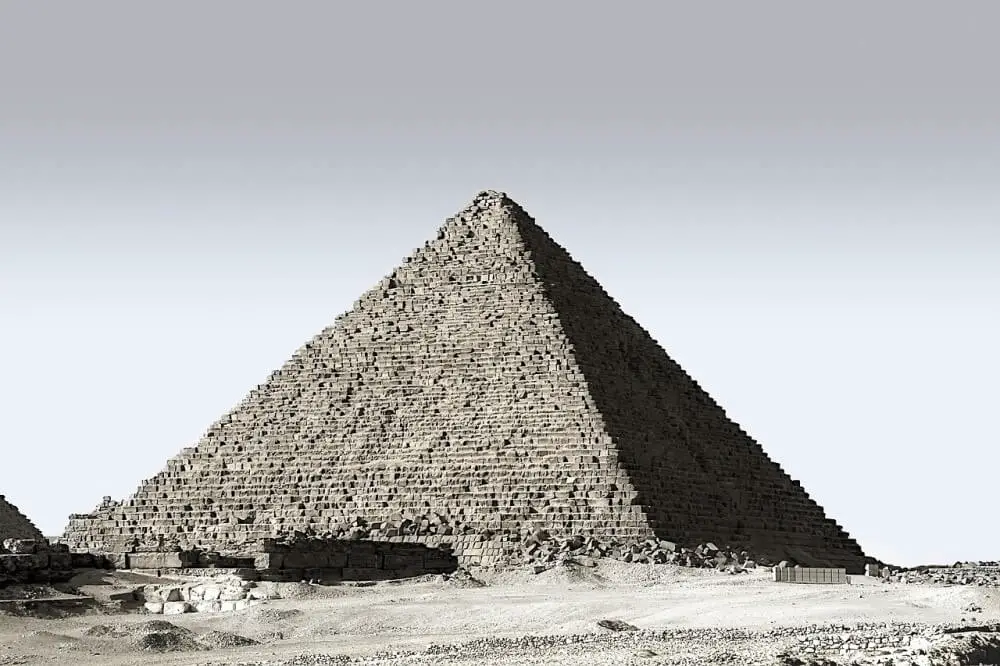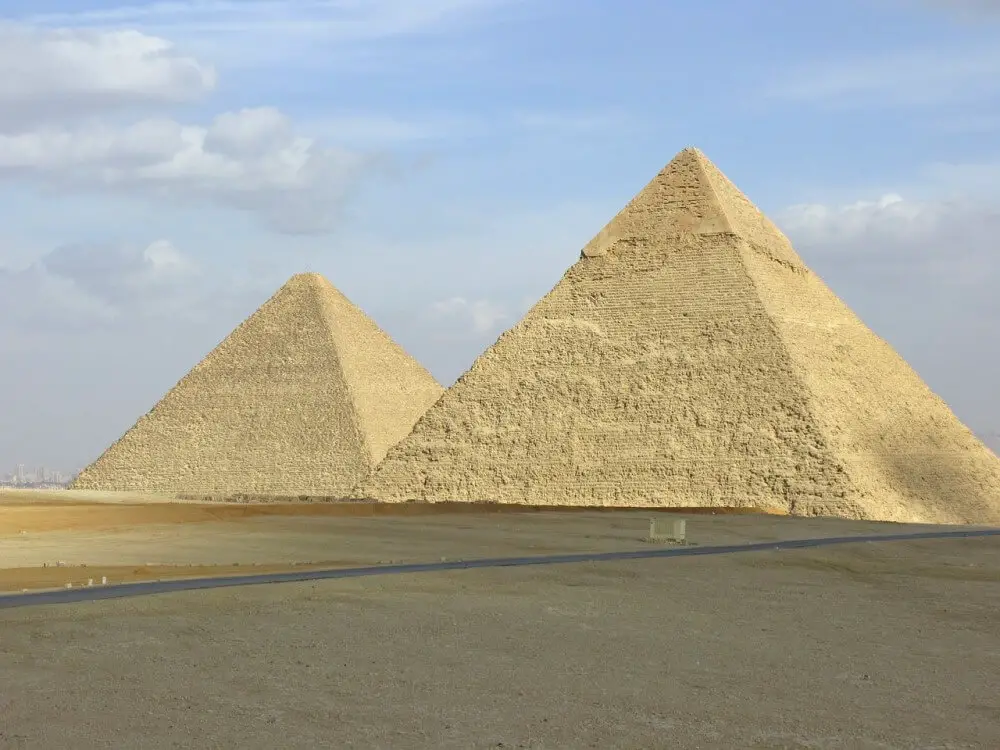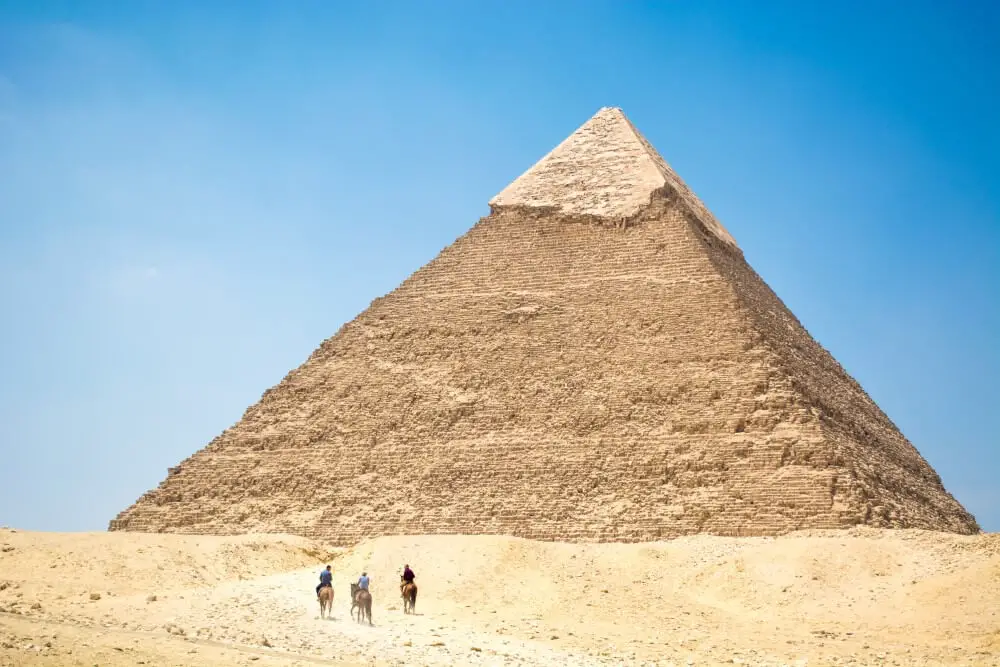As one of the world’s true architectural wonders, people from all corners of the globe have become intricately familiar with the appearance of the Pyramids of Giza. For more than 4,500 years, their origins and characteristics have been debated over by history lovers everywhere.
But what many modern observers may not be so sure of is what the Pyramids used to look like when they were first built. The iconic structures once boasted some very different physical features than they possess today, with one of the most interesting being a supposed gold top that was said to have adorned the top of the structures.
As with many Pyramid-based discussions, it isn’t immediately clear whether or not these ‘gold tops’ are based in reality, or whether they have been dreamed up in historical fantasy. Some have claimed for, and some vehemently against.
With that said, let’s answer the question: did the Pyramids have gold tops, and, if so, why did they disappear?

Did the Pyramids of Egypt really have gold tops?
Despite rumours to the contrary, it’s unlikely that the Pyramids really had solid gold tops covering the pinnacles of the structures. The existing evidence and historical documentation suggests that there were capstones (sometimes referred to as Pyramidions) placed on the top of the Pyramids, but these were made from granite or stone rather than gold.
That’s not to deny, however, that there may have been some gold involved in the making of the capstones. Some historians believe that there may have been a thin coating or gold-silver alloy covering many of the Pyramids’ capstones, although there is no direct evidence for gold being used in this way.
There is the possibility that this gold has been looted or gradually eroded away over time, leading to all traces being lost.
Although, it’s also worth noting that the ancient Egyptians built the Pyramids to last for eternity, taking great care to protect the contents of the burial chambers. Because of this, it’s arguably unlikely they would have left precious metals exposed, as they were aware of the risk of looting.
Explore our related articles:
Top 10+ Oldest Buildings in ChicagoTop 20 White Elephant Construction Projects Around the World
White House vs Capitol Building: What is the Difference?
Why is it a Mystery How the Pyramids were Built?
Top 10+ Construction Projects in Liverpool (2023)
Would it be Possible to Build the Pyramids Today?
Which Current Buildings will Last the Longest?
Why did the Pyramids have tops in the first place?
The capstones thought to have been used on many of the Pyramids were incorporated into the original designs for various interconnected reasons. These range from purely aesthetic benefits to added structural stability and high symbolic significance.
From an architectural perspective, the capstone served as the finishing decorative touch. It helped lend a sense of completeness and visual harmony to the respective pyramid’s overall design, ensuring maximum aesthetic appeal.
Symbolism also played a pivotal role in the inclusion of these tops. The Pyramids held profound cultural significance beyond their function as tombs, as they were powerful representations of the pharaoh’s divine authority and the belief in an eternal afterlife. A capstone is thought to have symbolised the pinnacle of the pharaoh’s earthly existence, signifying their journey towards the divine realm upon death.
In a more functional sense, capstones also had practical importance in the Pyramids’ construction. For, its underside was designed to align with a socket on the main pyramid structure, with this alignment serving as a critical element in ensuring the pyramid’s stability.
With all of these reasons and potential benefits in mind, the next natural question to ask is: where did the tops go, and why are they no longer a feature of the Pyramids?
Why did the Pyramids’ tops disappear?
To put it simply, there is no one definitive answer to why there are no longer tops on the Pyramids of Giza. It remains an enigma steeped in history, although there are thought to be several main factors that contributed to their disappearance.
The primary catalyst for potential gradual erosion is the simple passing of time. Exposure to the elements – wind, rain, sandstorms and more – over many centuries meant that the exterior surfaces of the pyramids succumbed to natural wear and tear. This gradual deterioration likely erased any remaining traces of precious materials, such as gold, that may have adorned them.
Looting and vandalism may have also played a big role in the disappearance. The prominent location and potential value of the tops made them appealing targets, with gold and other valuable materials often being pilfered and removed by profit-seeking vandals at other sites in the region.
There may be other, more indirect, factors at play too. The Ancient Egyptian period, and the ones that followed it, were tumultuous in the extreme. It has been contended that, during times of political upheaval, invasion or shifting power dynamics, the deliberate destruction or removal of pyramid tops may have occurred as they symbolised the authority of previous regimes.
Indeed, the recycling of materials from older structures for new projects was a common practice in ancient Egypt. As a result, materials that once adorned the pyramid tops, such as gold or precious stones, may have been repurposed, further obscuring their original appearance.
The truth is, however, that the full reason behind the disappearance of the Pyramids’ tops will never be known, barring further archaeological discovery. While records of the Pyramids’ construction and initial appearances exist, detailed accounts of their gradual decay or modification over time are scarce.
So, given these mysterious factors, will there ever be a time where we turn back time and replace the tops of the Pyramids?

Will we replace the Pyramids’ tops?
As tantalising a proposition as rebuilding the Pyramids’ tops is, it’s almost certain that this will never be attempted. This is due to a variety of practical, historical, and cultural considerations.
First and foremost, the current state of the pyramids, including their missing tops, bears the marks of age, and introducing new tops would require extensive rebuilding work. This foundational work would potentially threaten to not only damage the existing structure but also potentially reduce its authenticity for future generations.
After all, the Pyramids are not mere architectural structures; they stand as profound symbols of ancient Egypt’s historical and cultural heritage. They embody the period’s grandeur and the divine authority of its pharaohs, as well as its beliefs surrounding the afterlife. So, any endeavour to replace their tops would likely be seen as a disruptive imitation of this sacred purpose.
Indeed, from an archaeological and historical standpoint, the Pyramids continue to be subjects of fascination and exploration. Replacing their tops might hinder efforts to delve into and comprehend the original construction techniques and materials employed by ancient Egyptians.
And this is not taking into account the potential economic impact of reduced tourist interest should the Pyramids be altered from their current form. The pyramids are major visitor attractions, playing a pivotal role in Egypt’s economy, and changing their appearance could have far-reaching economic consequences.
That’s it for our handy guide to whether the Pyramids really did have gold tops. As with many aspects of the iconic structure’s existence, there’s little doubt that their existence will continue to be debated and deliberated upon for years to come.
For more related news, views and in-depth guides, take a look at some of our other articles on historical buildings. They feature a comprehensive guide to why gargoyles feature on church exteriors, as well as a comparison of the differences between the White House and the Capitol Building.
Or, if you’d like more guides to building and architecture vocabulary, explore our selection of building wikis, including what the definition to ha-ha is.
Last Updated on 17 September 2023 by Michael
